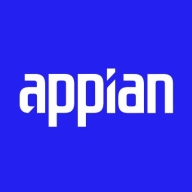

Appian and Comindware Tracker are prominent products in the business process management sector. Appian appears to have an advantage in terms of ease of use and comprehensive features.
Features: Appian offers a low-code development platform that supports rapid application development and integration with enterprise systems. It includes intuitive dashboards and comprehensive reporting tools that enhance data visibility. Comindware Tracker excels in advanced workflow automation and case management, allowing processes to be tailored to specific business needs.
Room for Improvement: Appian could improve by further simplifying its steep learning curve and enhancing its customization options. Its pricing model can be cost-prohibitive for smaller businesses, and some users report needing better offline capabilities. Comindware Tracker might benefit from improving its mobile platform and expanding integration capabilities. It can also work on enhancing user interface designs for more intuitive navigation and faster reporting tools.
Ease of Deployment and Customer Service: Appian's cloud-based deployment offers scalability and reduces IT overhead, with strong customer service known for quick responses. Comindware Tracker provides adaptable deployment options with both on-premises and cloud solutions, supported by dependable customer service ensuring operational smoothness. Appian's cloud deployment encourages quicker implementation, while Comindware Tracker's deployment flexibility caters to different infrastructure needs.
Pricing and ROI: Appian often involves a higher initial investment, though its extensive features can justify the cost over time with substantial ROI. Comindware Tracker provides a more competitive pricing structure with lower entry costs, offering a quick ROI through workflow optimization.
Appian is very efficient, allowing us to build a lot of applications within a financial year, making it cost-effective.
Their customer service is responsive, and the team is very prompt for support.
The technical support is generally good.
Appian has a community where I can put my questions.
Appian is scalable, but it depends on how you build your applications.
Initially, without much coding, I can easily handle five thousand records.
It depends on how it has been designed and how it has been configured.
I would like to see more enhancement in the user interface to allow more freedom in designing the sites and pages.
If there is a very complex process that includes a lot of data transitioning and memory-centric processes, it consumes a lot of memory.
On the pricier side, both Appian and Pega are enterprise-level solutions, placing them on the slightly higher side.
The pricing of Appian is based on the number of users and generally ranges from 70 to 100 USD per user per month.
The zero-code integration feature is remarkable, allowing for ease of data transfer and workflow enhancement.
It is easy for me to define the process and create configurable workflows.
I can create tables, perform database-related activities, and create multiple tables.

Appian is a unified low-code platform and solution used by businesses to build enterprise applications and workflows. This product adapts to the needs of clients and the technologies they are already using to combine their data in a single workflow and maximize resources. The platform has four main components through which it transforms the work process for companies of various sizes. They are:
Appian is utilized across a diverse set of industries, including automotive and manufacturing, energy and utilities, education, financial services, telecom and media, transportation, retail, insurance, healthcare, and life sciences. The most frequent use cases of Appian are customer journey, governance, risk and compliance, operational efficiency, supply chain, distributed order management, and environmental, social, and governance (ESG) management.
Appian Features
Appian has various features that allow users to create solutions for their businesses. These features can be separated into a few groups according to function, including automation, low-code application development, and integrations and data. Some of the most frequently used features of Appian include:
Appian Benefits
The benefits of using Appian include:
Reviews from Real Users
A practice leader - digital process automation at a computer software company values Appian highly because the product is easy to develop, low-code, and has a good user interface.
Alan G., an advisory board member at Codecon VR, Appian offers a clear application life cycle, easy to learn documentation, and comes with a fundamentals course.
Non-coding workflow software for business process modelling and management, automation of business operations, and workflow productivity boost. Minimize dependency on IT and allows non-technical users to design, run and modify Workflows with drag-and-drop simplicity.
A wide variety of workflow management solutions have been built with Comindware Tracker across all industries, departments, and workflow scenarios and brought transparency and accountability in businesses.
Key benefits of Comindware Workflow Software:
The Workflow Management system enables non-code addition and modification of workflows with no interruption to ongoing activities. It ensures quick-win implementation and reduces expenses.
We monitor all Business Process Management (BPM) reviews to prevent fraudulent reviews and keep review quality high. We do not post reviews by company employees or direct competitors. We validate each review for authenticity via cross-reference with LinkedIn, and personal follow-up with the reviewer when necessary.